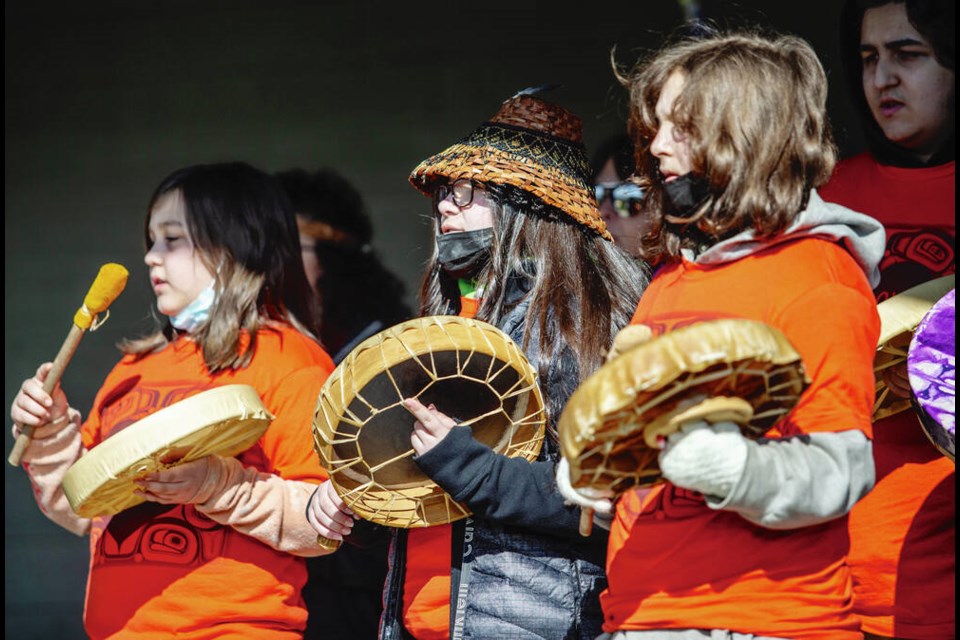The creation of an Indigenous Protected Area on the Department of National Defence land known as Mary Hill in Metchosin is “reconciliation in action,” says the chief of the Sc’ianew (Beecher Bay) First Nation.
Russ Chipps signed a “standstill agreement” with the District of Metchosin, Habitat Acquisition Trust and Pearson College UWC, meaning if it acquires the 435-acre waterfront Mary Hill site through the treaty process, it will leave aside a large portion as an Indigenous Protected Area.
“We aren’t just talking about reconciliation — we are demonstrating it with this friendship and actions. We are working together as equals, to do this in a good way,” Chipps said during a ceremony at Metchosin’s municipal hall Thursday.
The DND property at Mary Hill — once part of a coastal defence system — has been closed to the public since the Second World War. The land is considered surplus, slated for disposal by the federal government.
When a treaty agreement is reached between the Sc’ianew and federal and provincial governments, the nation will own the Mary Hill land and ultimately decide what to do with it. The Sci’anew and four other Coast Salish First Nations are negotiating treaties together as part of the Te’mexw Treaty Association negotiations.
The nation has been exploring two main options — a real estate development that would generate revenue for the nation through sales or leases and taxes, and preserving the lands in their current state while also allowing economic development and activities that are compatible within a protected area.
Under the standstill agreement, if the nation decides to create a protected area on its treaty settlement lands, the partners would undertake fundraising so the nation is “fairly compensated” for revenue that could have been obtained through land development.
“We are working to achieve something that most of us never thought was possible,” Metchosin Mayor John Ranns said. “We want to preserve a part of the region that is important to all of us and to enhance the ability of Sc’ianew to further develop a strong socio-economic foundation.”
Included in the proposed Indigenous Protected Area is about 36 acres of undeveloped Pearson College-owned land adjoining the main campus.
“Pearson College UWC is, to our knowledge, the first educational institution in Canada to voluntarily add its land to a true community effort dedicated to preserving this precious natural environment through Indigenous-led initiatives,” said Pearson College president Craig Davis.
Habitat Acquisition Trust promises to provide guidance and expertise on reaching conservation goals, and assist with resources, services and fundraising support.
Katie Blake, executive director of Habitat Acquisition Trust, said the Mary Hill lands represent “a pristine example” of the last 15 per cent of old-growth coastal Douglas fir and also includes fragile Garry oak meadows. She said when considering options for protecting the forest, an Indigenous Protected Area is more desirable than conventional park models that can often “alienate Indigenous communities.”
The total size of the Mary Hill lands is 435 acres and the minimum size anticipated for a future Indigenous Protected Area is 338 acres. This expanse does not include the 98 acres of contiguous land that is being held back by DND to ensure public safety and ongoing DND operations on an adjacent site.
It’s not the first time that Metchosin has worked with the Sc’ianew First Nation. In 2017, the district engineered a land swap with the Sc’ianew Nation and Langford to transfer three parcels of Crown land totalling 250 acres — which it received as part of a treaty agreement — to Metchosin to create a buffer at the Langford border.
The parcels of land are protected as green space, while the Sc’ianew received partial ownership in a business park on land straddling the Langford and Metchosin border.
Metchosin residents approved the deal in a referendum, voting 76% in favour.



